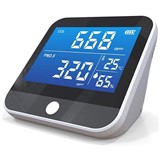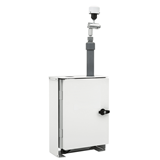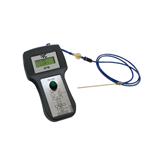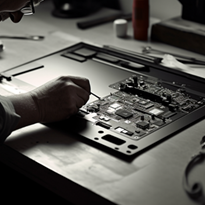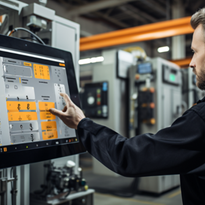Industrial touch screen monitors have become indispensable tools in the industrial landscape, revolutionizing the way operators interact with machinery, control systems, and data visualization. As technology continues to advance at a rapid pace, industrial touch screen monitors are poised to undergo transformative innovations that will elevate user engagement, experience, and functionality to unprecedented heights.
In this comprehensive exploration, we delve into the latest innovations and future trends in industrial touch screen monitors for industrial applications.
From interactive 3D displays and haptic feedback to edge-to-edge designs and advancements in touch screen materials, we uncover the cutting-edge developments that are shaping the future of touch screen technology in industrial environments.
1.Interactive 3D Displays: Pioneering New Levels of User Engagement:
Interactive 3D displays mark a paradigm shift in touch screen technology, redefining the way users engage with digital content and interact with industrial processes. This transformative innovation combines the immersive nature of 3D visuals with the intuitive touch interface, offering operators unprecedented levels of engagement, efficiency, and decision-making capabilities.
Here are the key features that set them apart as game-changers in the world of industrial touch screen monitors.
-
A Multidimensional User Experience
Interactive 3D displays introduce a new dimension of interactivity, immersing operators in a visually stunning and lifelike environment. Unlike traditional 2D touch screens, where interactions are confined to a flat plane, 3D displays allow operators to manipulate objects and data points in three-dimensional space. This multidimensional user experience brings a sense of depth and realism, enabling operators to interact with digital content as if it were physical, tangible elements within their grasp. In industrial applications, this level of immersion opens up a wide array of possibilities, from exploring complex models to visualizing intricate machinery and processes in vivid detail.
-
Enhanced Data Visualization and Analysis
In industrial settings, data visualization plays a crucial role in understanding complex processes and making informed decisions. Interactive 3D displays take data visualization to an entirely new level by presenting information in a visually engaging and context-rich manner. Operators can rotate, zoom, and pan 3D models, gaining insights from multiple perspectives and angles. This enhanced visualization empowers operators to analyze data more comprehensively, identify trends, and detect anomalies that might have otherwise remained hidden in traditional 2D representations. In scenarios where precision is paramount, such as engineering design, product development, or architectural planning, interactive 3D displays provide invaluable support for data-driven decision-making.
-
Training and Simulation Advancements
Training and simulation are critical components of various industrial processes, allowing operators to practice and refine their skills in a safe and controlled environment. Interactive 3D displays revolutionize training and simulation by offering lifelike scenarios and realistic interactions. Operators can participate in virtual simulations that mimic real-world conditions, enabling them to practice equipment operation, emergency response protocols, and complex procedures with unparalleled realism. This level of training immersion ensures that operators are well-prepared to handle challenging situations, leading to increased competence and confidence in their tasks.
-
Gesture-Based Interactions and Natural Navigation
Interactive 3D displays often support gesture-based interactions, adding another layer of intuitiveness to the touch experience. Gestures such as pinch-to-zoom, swipe, and rotate are seamlessly integrated into the 3D environment, allowing operators to navigate and manipulate content effortlessly. This natural and gesture-driven navigation eliminates the need for complex menu structures and on-screen controls, simplifying the user interface and streamlining interactions. In industrial settings where time is of the essence, gesture-based interactions facilitate quicker task completion, reducing the cognitive load on operators and enhancing overall productivity.
-
Design and Prototyping Advantages
The industrial design and prototyping process greatly benefit from interactive 3D displays. Designers and engineers can visualize product concepts in full 3D, making it easier to spot design flaws or optimization opportunities. Interactive 3D displays allow for on-the-fly modifications, enabling real-time adjustments to design elements and evaluating their impact instantaneously. This iterative design process accelerates product development cycles and reduces the need for physical prototypes, ultimately saving time and resources.
As this technology continues to evolve, industries can expect even greater advancements, further elevating their operational efficiency, productivity, and overall performance.
2. Haptic Feedback and Tactile Sensations: Enhancing User Experience:
Haptic feedback is a cutting-edge technology that adds tactile sensations to touch screen interactions. This enhancement enriches the user experience in industrial touch screen monitors in the following ways:
- Tactile Realism: Haptic feedback provides users with a sense of touch, making on-screen elements feel more tangible. For industrial applications, this tactile realism enhances the feel of virtual buttons, switches, and sliders.
- Improved Precision: With haptic feedback, operators receive confirmation of their touch inputs through vibrations or subtle movements. This feedback increases touch accuracy and reduces accidental touches, especially in high-stress environments.
- Alerts and Notifications: Haptic feedback can be utilized to deliver alerts or notifications to operators discreetly. In noisy industrial settings, haptic feedback ensures that important messages are noticed even without audible alerts.
- Virtual Texture Perception: Haptic technology can create virtual textures on the touch screen, giving operators the sensation of interacting with different materials, which can be valuable in certain industrial training simulations.
- Medical and Surgical Training: In medical and surgical training, haptic feedback enhances the realism of virtual procedures, providing aspiring medical professionals with hands-on training experiences.
3. Edge-to-Edge and Frameless Designs: Maximizing Screen Real Estate:
Edge-to-edge and frameless designs are futuristic trends that maximize the usable screen real estate, offering the following advantages:
- Seamless Aesthetics: Edge-to-edge and frameless designs create a sleek and modern appearance that seamlessly integrates the touch screen monitor into industrial equipment or control panels.
- Increased Display Size: By eliminating bezels and frames, touch screen manufacturers can increase the actual display size within the same physical dimensions, providing operators with more visual information at a glance.
- Improved Multi-Monitor Setups: Frameless designs are ideal for multi-monitor setups, as they enable smooth and uninterrupted transitions between adjacent touch screens, fostering better continuity and usability.
- Reduced Reflection and Glare: Edge-to-edge displays reduce the presence of bezels that could cause reflections or glare, resulting in better screen visibility and reduced eye strain for operators.
- Increased Hygiene: Frameless designs are easier to clean and maintain, as there are no gaps or crevices for dust and debris to accumulate, making them particularly suitable for industrial environments with stringent hygiene requirements.
4. Advancements in Touch Screen Materials: Durability and Sensitivity Improvements:
Touch screen materials are continuously evolving to enhance durability, sensitivity, and overall performance for industrial use. Key advancements include:
- Strengthened Glass: Industrial touch screen monitors are adopting strengthened glass materials, such as Corning's Gorilla Glass or Dragontrail glass, which offer superior resistance to scratches, impacts, and chemical exposure.
- Improved Scratch Resistance: Advanced coatings and treatments are applied to touch screen surfaces to improve scratch resistance, maintaining optical clarity and ensuring long-term durability.
- Enhanced Sensitivity: New touch screen materials and technologies enable higher touch sensitivity, allowing for effortless interactions with even light touches or gloved hands, critical in industrial applications.
- Chemical and Solvent Resistance: Touch screen materials are engineered to resist damage from various chemicals and solvents commonly found in industrial environments, ensuring reliable and long-lasting performance.
- Anti-Glare and Anti-Fingerprint Treatments: Touch screen materials often incorporate anti-glare and anti-fingerprint treatments to minimize reflections and smudges, ensuring clear visibility and ease of use.
5. Enhanced Security Features and Biometrics for Industrial Applications:
Security is a paramount concern in industrial environments, and touch screen monitors are incorporating advanced features to safeguard sensitive data and operations. Consider the following advancements:
- Biometric Authentication: Touch screen monitors are integrating biometric authentication methods such as fingerprint scanning or facial recognition to ensure only authorized personnel can access critical systems.
- Secure Access Controls: Advanced security protocols and access controls are being implemented to prevent unauthorized access to sensitive data or control functions, reducing the risk of security breaches.
- Encrypted Data Transmission: Touch screen monitors are adopting encrypted data transmission protocols to protect data integrity during information exchange, safeguarding against data interception or tampering.
- Intrusion Detection and Reporting: Some touch screen monitors are equipped with intrusion detection systems that detect and report any tampering attempts or physical breaches, enabling swift response to potential security threats.
- Multi-Factor Authentication: In high-security environments, touch screen monitors may support multi-factor authentication, combining biometrics, PINs, or access cards for heightened security layers.
6. Integrating Artificial Intelligence: Enabling Smart Touch Screen Monitors:
Artificial Intelligence (AI) is spearheading a transformative revolution in touch screen technology, unlocking a new realm of possibilities and capabilities that were once the realm of science fiction. By imbuing industrial touch screen monitors with intelligence and machine learning capabilities, AI is paving the way for smart features and personalized user experiences that significantly enhance the functionality, efficiency, and overall usability of touch screen devices. In this ever-evolving landscape, AI is not just a buzzword but a tangible force that is shaping the future of touch screen technology in profound ways.
One of the most remarkable aspects of AI-powered industrial touch screen monitors is their ability to adapt and learn from user interactions. Through machine learning algorithms, these monitors can analyze user behavior, preferences, and patterns, allowing them to tailor the user interface and functionality to individual users' needs. This personalization leads to a more intuitive and efficient touch experience, where commonly used functions and applications are readily accessible, and the interface is streamlined to match each user's workflow.
AI-driven industrial touch screen monitors also excel in predictive capabilities, anticipating user needs before they even occur. By analyzing historical data and real-time inputs, these monitors can predict user intentions, whether it's suggesting relevant apps, displaying frequently used tools, or predicting the next steps in a particular process. This proactive approach not only saves time but also reduces cognitive load, enabling operators to focus on higher-level tasks and decision-making.
The integration of AI in industrial touch screen monitors offers the following benefits:
- Predictive Maintenance: AI-powered touch screen monitors can analyze equipment performance data and predict maintenance requirements, helping operators proactively address potential issues and reduce downtime.
- Contextual User Interfaces: AI can adapt the touch screen interface based on the operator's tasks, context, and preferences, providing a more intuitive and personalized user experience.
- Voice Commands and Natural Language Processing: AI-driven touch screen monitors can support voice commands and natural language processing, enabling hands-free interactions for operators while performing tasks.
- Intelligent Alerts and Notifications: AI can analyze real-time data and provide intelligent alerts and notifications to operators, allowing them to focus on critical events and actions.
- Machine Learning for Process Optimization: AI-driven touch screen monitors can leverage machine learning algorithms to optimize industrial processes, enhancing efficiency and resource utilization.
7. Exploring Industry-Specific Applications of Advanced Touch Screen Technologies:
Different industries have unique needs and challenges, and advanced touch screen technologies are being tailored to cater to specific industrial applications. Consider the following industry-specific applications:
- Automotive Manufacturing: Advanced touch screen monitors with 3D visualization and haptic feedback enhance design, prototyping, and quality control processes in the automotive manufacturing industry.
- Aerospace and Aviation: Edge-to-edge displays with biometric authentication find applications in aerospace and aviation for secure access control to sensitive avionics systems.
- Healthcare: Touch screen monitors with AI-driven voice commands and predictive maintenance capabilities optimize medical device operations and support remote patient monitoring.
- Food and Beverage Processing: Touch screen monitors with enhanced durability and chemical resistance improve efficiency in food and beverage processing environments, where strict hygiene requirements prevail.
- Oil and Gas Exploration: Advanced touch screen materials that withstand extreme temperatures and rugged conditions are essential for touch screen monitors used in oil and gas exploration and drilling operations.
The future of touch screen monitors for industrial use is brimming with innovations that promise to revolutionize the way operators interact with technology in manufacturing, process control, and other industrial settings. Interactive 3D displays, haptic feedback, edge-to-edge designs, advanced touch screen materials, biometrics, AI integration, and industry-specific applications are shaping the next generation of touch screen technology. These advancements are set to elevate user engagement, enhance user experiences, improve operational efficiency, and provide unprecedented levels of customization and functionality for industrial professionals. As these innovations continue to evolve, touch screen monitors are poised to become even more instrumental in driving productivity, safety, and progress in industrial operations across various sectors.

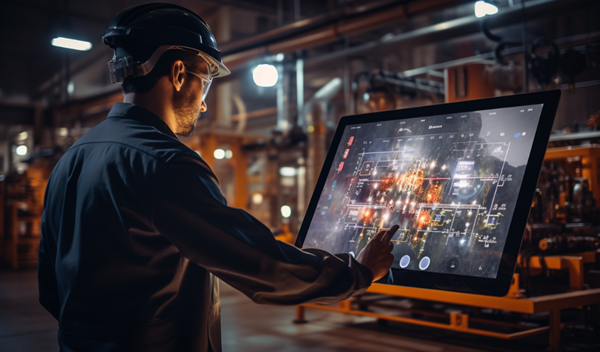

-160x160-state_article-rel-cat.png)




